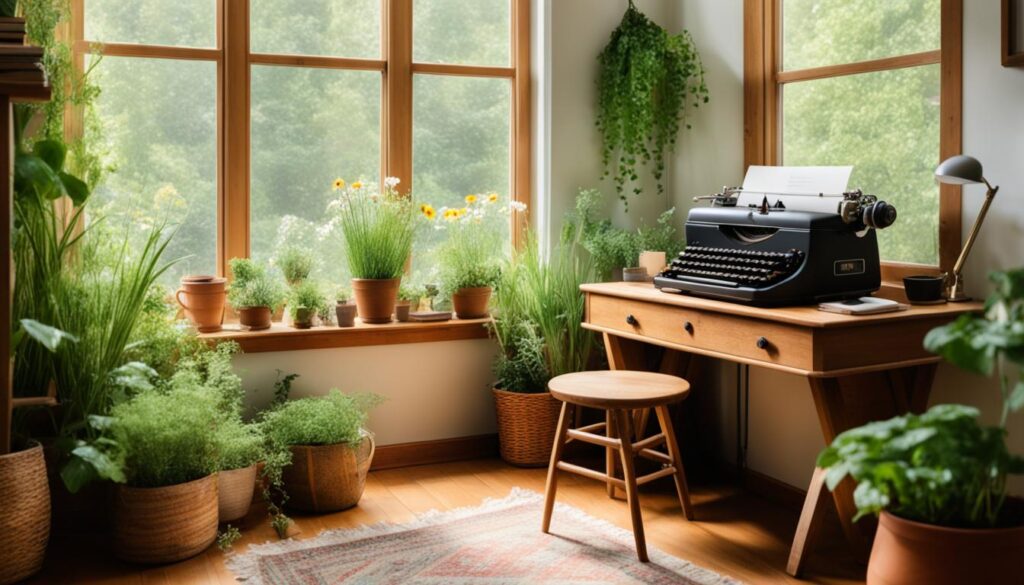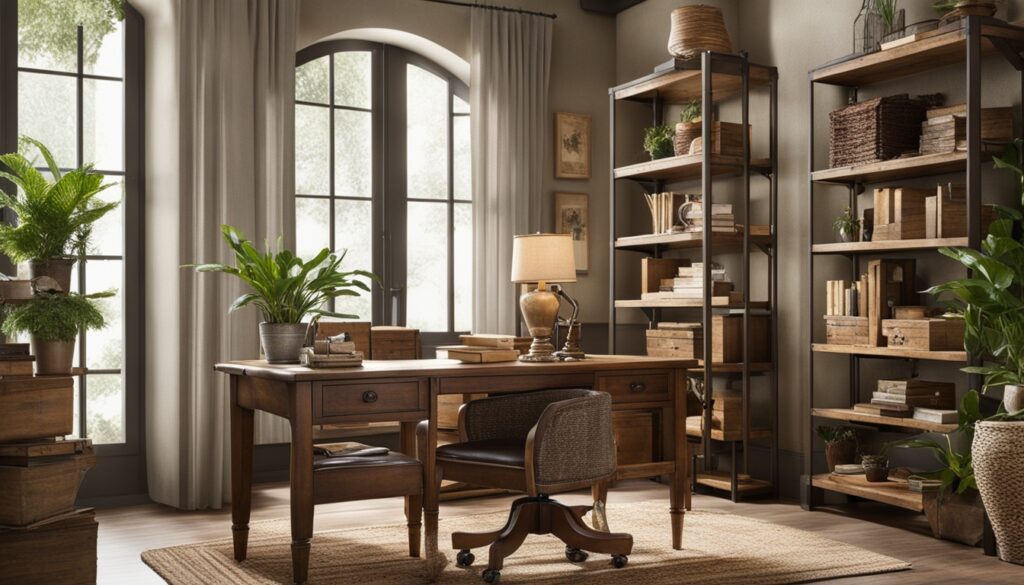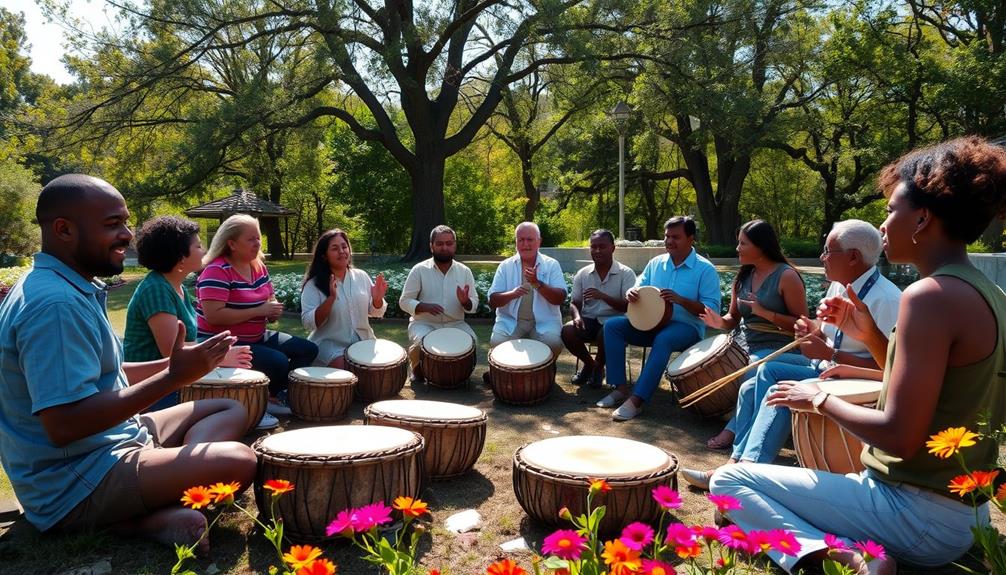Imagine a workspace as a cozy retreat from today’s fast pace. Imagine it filled with vintage charm, where each furniture piece has its own tale. The cottagecore home office is more than a trend. It’s an invite to cherish simplicity and bond with nature. With rustic beauty, it turns your work area into a calm haven, bringing back dreams of calm countryside life.
This trend gives us a fresh view, celebrating slow living and enjoying small joys. As you design your dream cozy office, let the warm shades of old wood and soft floral fabrics guide you. This article will show you how to make a cottagecore home office. It will be a place for creativity, comfort, and showing your unique style.
Key Takeaways
- The cottagecore aesthetic celebrates rustic charm and vintage aesthetics.
- Incorporating soft, neutral shades can create a calming environment.
- Natural materials like wood and stone enhance the cozy atmosphere.
- Vintage furniture adds character to your workspace.
- Using house plants can help bring nature indoors.
- Cozy textiles contribute to a warm, inviting workspace.
- Layering rugs adds both comfort and style.
Understanding the Cottagecore Aesthetic
The cottagecore aesthetic is all about living simply and enjoying nature. It has become more popular over the last ten years. People love the romantic parts of country life it brings into fashion and decorating.
It shows us images of lovely gardens and quiet, rural scenes. This style makes you want to bring simplicity in design into your home. Using natural materials like linen adds warmth and coziness.
Layering quilts and finding old treasures make your space feel relaxed and full of stories.
To really get the cottagecore look, bring nature inside. Fill your home with indoor plants, flowers, and nature-themed decor. Adding wooden and earthenware pieces can tie the whole rustic look together.
This design loves soft colors like light yellows, greens, and greys. They make your home feel calm and inviting. Fabrics with flowers and layers add snug comfort. Showing off second-hand finds and family heirlooms makes your space more special.
Combining these ideas helps you create a cozy home that shows who you are. You might use old books, quirky chairs, or decor that feels like it’s from a different time. The cottagecore style is a lovely way to cherish the simpler aspects of life.
What is a Cottagecore Home Office?
A cottagecore home office is a peaceful spot that feels like the countryside. It combines old-style charm with useful design for work. This special workspace is filled with nature, old decorations, and things that make it comfy and effective.
Picture shelves full of classic books and handcrafted items around you. This cozy place makes working feel like part of nature’s calm. You’ll find:
- Vintage Finds: Old pieces from flea markets or sites like Craigslist and Facebook Marketplace add unique flair.
- Natural Touches: Adding indoor plants, dried flowers, and pottery makes the space peaceful.
- Warm Lighting: Lights like Edison bulbs offer a soft, inviting light.
- Functional Decor: Vintage pieces not only look good but can also hold your files.
Creating a cottagecore office means making careful choices. You pick out ancient furniture and decide how to arrange things. Colors, textures, and big floral designs are essential. They make the space attractive and encourage taking it easy while working.

Rustic Furnishings for Your Home Office
Selecting the right furnishings is key for a cozy home office. Rustic elements like wooden desks and vintage seats make it inviting. They bring an old-school charm, making your space both productive and peaceful.
Think about how each piece fits into your home office’s look.
Choosing Distressed Wooden Desks
Distressed wooden desks are vital for a rustic office. They add warmth and history, perfect for the cottagecore style. Look for desks with natural flaws and textures. These features add character and authenticity.
- Durability and longevity.
- Unique appearances that enhance the rustic vibe.
- Functionality combined with charm.
Incorporating Vintage Floral-Printed Seating
Vintage floral seating matches well with your wooden desk. It offers comfort and brings color and personality. Pick chairs or cushions with nature patterns. They fit the cottagecore theme perfectly.
- Enhanced comfort for long work hours.
- A unique design that differentiates your office.
- Connection to traditional craftsmanship.

To sum it up, rustic furnishings make your home office warm and welcoming. Choosing the right wooden desks and floral seating boosts your daily work experience. It makes your space functional and beautiful.
Bringing Nature Indoors
Adding natural elements to your home office shows what cottagecore decor is all about. House plants make the space feel peaceful and linked to nature. They improve the air quality, combining beauty with health benefits.
Utilizing House Plants for a Cozy Atmosphere
House plants turn any office into a cozy retreat. Choose plants like snake plants, spider plants, or ferns to boost the cottagecore look. These plants can sit on your desk or windowsill, creating a warm and soothing space.
Incorporating Natural Light with Sheer Curtains
Sheer curtains are great for letting in plenty of sunlight. They softly diffuse light, keeping the room bright but private. This natural light makes the room feel open and sparks creativity, connecting you to the beauty of nature.

Cottagecore Decor: Color Palettes and Patterns
The cottagecore aesthetic brings back the joy of simple living. It uses serene color palettes and lovely patterns. This style adds softness and warmth to your home office. To get this look, use soft colors and natural materials to make a peaceful workspace.
Soft, Earthy Tones for a Soothing Workspace
Cottagecore decor colors include pastel hues, creamy whites, and earthy tones. These soft colors make your environment more calming. Choose shades like sage green, blush pink, or taupe. They create a cozy vibe that fits with wooden furniture and vintage items. This mix boosts creativity and keeps a rustic charm.
Mixing Floral Prints with Solid Textures
Cottagecore patterns often have fun floral prints. Combine these with solid textures for a unique look. Think about adding patterned throw pillows or curtains by a wooden desk. This mix of textures and colors makes a place welcoming. It highlights personal style and comfort.

| Color Palette | Floral Patterns | Suggested Textures |
|---|---|---|
| Sage Green | Small Rose Patterns | Soft Cotton |
| Blush Pink | Daisies | Woven Fabrics |
| Taupe | Wildflower Motifs | Natural Linen |
| Pale Blue | Floral Borders | Textured Cushions |
Creating a Warm and Inviting Atmosphere
To make your cottagecore home office warm and inviting, mix cozy textiles and thoughtful design. It’s all about comfort and style, making the space perfect for work and relaxation.
Using Cozy Textiles like Throw Blankets
Adding cozy textiles is crucial for that welcoming feel. Try soft throw blankets on your chair or couch. This invites you to relax or work comfortably. Plush pillows turn seating into cozy spots, adding both warmth and style.
Layering Rugs for Comfort and Style
Layering rugs adds both comfort and style. Put a large area rug with a smaller one on top for a cozy touch. It makes you want to stay and work longer. Textures combine to make your office comfy and stylish.

The Importance of Vintage Accents
Adding vintage accents to your cottagecore home office brings warmth and history. These touches enhance the room’s charm. They create an atmosphere filled with stories of personal experiences and memories. When selecting items, think about their look and usefulness.
Displaying Antique Finds as Functional Decor
Vintage books, ornate frames, and unique trinkets give your workspace character. They start conversations and can be practical too. Blending style and function makes your office inviting and productive. Consider a shelf or table for these vintage accents. They should improve the look and evoke nostalgia.
Using Heirloom or Vintage Stationery and Supplies
Heirloom stationery links you to the past, boosting creativity in your workspace. Papers with unique textures turn boring tasks into fun. Include vintage pens, ink, and letterpress in your routine. These items showcase past craftsmanship, enhancing writing’s beauty. By choosing these pieces, your workspace becomes personal and inspiring.

Utilizing Natural Materials
Use natural materials to make your cottagecore home office warm and inviting. Wood accents and stone make the space cozy. They bring the beauty of nature inside, creating a charming workspace.
Incorporating Wood and Stone Elements
Wood accents add rustic elegance. Desks and shelves of reclaimed wood are not only beautiful but also eco-friendly. A feature wall of brick or stone makes the space feel solid. It pairs well with your work style.
Employing Wicker Baskets for Organization
Wicker baskets are practical and stylish. They keep your workspace neat and add texture. These items fit the cottagecore theme perfectly, offering a lovely way to reduce clutter.

Candlelight and Ambient Lighting
Having the right vibe in your cottagecore home office is key for both productivity and comfort. Ambient lighting plays a big part in this, creating a warm, inviting feel. Adding warm bulbs can give your space a cozy glow, perfect for relaxing while you work.
Choosing Warm Bulbs for a Cozy Glow
Picking the correct light fixtures is crucial. Go for warm bulbs that give off a soft light. These bulbs make your workspace peaceful, helping you focus and relax. Look for brands like Philips and GE for warm-colored LED lights. They’re ideal for that cottagecore look, adding to the warmth and charm of your office.
Creating Atmosphere with Candles and Lanterns
Adding candles and lanterns brings extra charm. Opt for natural beeswax or soy candles for a cozy light. Along with candles, add decorative lanterns for added light and style. These touches make your office feel serene, sparking creativity.

cottagecore-home-office: Blending Functionality and Charm
Your cottagecore home office should blend function and charm, boosting your productivity. Choose ergonomic furniture with a vintage look for comfort during long work hours. Rustic elements like distressed mirrors and handmade quilts add texture and complement the decor. Decorative items, such as mason jars and dried flowers, make the room welcoming.
A cottagecore workspace encourages creativity and well-being. Display framed botanical prints and intricate patterns on walls to connect with nature. Use jute rugs and wicker baskets for an eco-friendly organization. A mix of soft pastels and earthy tones enhances the cozy feel.
Design flexibility lets you personalize your cottagecore office. Create reading nooks or a tea corner to show off this style’s versatility. Adding pastel textiles and whimsical touches brings warmth and charm. This balance of style and practicality keeps your workspace beautiful and functional.

| Design Element | Functional Aspect | Charm Factor |
|---|---|---|
| Ergonomic Furniture | Comfort during long hours | Vintage aesthetics |
| Rustic Decor | Inspires creativity | Cozy atmosphere |
| Naturally Sourced Materials | Eco-friendly organization | Organic charm |
| Pastel Colors | Soothing environment | Inviting warmth |
| Whimsical Accessories | Functionality as decor | Unique personal touches |
Bringing Seasonal Changes into Your Workspace
Changing your workspace with the seasons adds a nice touch of freshness. It lets you embrace the cottagecore vibe. Decorating for each season lets you be creative with your home office. It turns it into a bright spot that reflects the changing world outside.
In spring, think about adding pastel shades like pink, lavender, and mint green. Use soft items like cushions and throws. These colors make your space feel light and open. When summer arrives, go for bright colors like coral and aqua. They’re great for adding a touch of the sun’s warmth to your place.
With autumn, bring in warm colors like terracotta and mustard yellow. Add seasonal flowers or rustic wreaths to up your office’s charm. In winter, pick soft items in deep reds and greens. They create a cozy feel, especially with the soft light of a candle.
Here are some seasonal update tips:
- Have a changing display of seasonal flowers.
- Add themed fabrics that show off each season’s vibe.
- For a country feel, decorate with things like pinecones or branches.
To change your workspace with the seasons, first declutter. Keep only things that make you happy or are useful. Getting rid of stuff you don’t need helps you find new seasonal items.
Enjoy seasonal activities like gardening in spring or cozy reading by the fire in winter. Making your cottagecore workspace match the season makes it comfy. It also helps you feel more connected to nature’s cycles.

Combining Cottagecore with Modern Comforts
Mixing modern comforts with cottagecore style makes your space both welcoming and useful. This design integration lets you enjoy rustic charm and modern ease together. Imagine ergonomic furniture that is also stylish. A nice desk with a comfy chair can boost your work and make your space look warm.
Modern features also mean energy-saving kitchen gadgets. Imagine old-timey plates on shelves and high-tech coffee makers, keeping a country vibe. These cottagecore blends let you cook with retro tools but enjoy the latest tech.
The colors in this design mix stay true to cottagecore’s soft hues, with deep blues and greens setting a calming scene. Floral patterns and raw wood mix well with modern sleekness, making a lovely contrast. This contrast makes the style stand out more.
Adding handmade items to your décor makes your space unique and eco-friendly. This mix adds a personal touch and shows off creativity, important in cottagecore. Using old-fashioned items with modern ones creates a space that’s all about you and comfort.

Conclusion
The cottagecore home office look brings simplicity and nature into your work area. Adding rustic touches transforms your space, mixing comfort with creativity. With vintage pieces, soft textiles, and nature’s beauty, your office becomes a cozy place that boosts work and relaxation.
Your office turns into a calm haven away from daily stress. By picking elements that fit your style, your space keeps its classic charm. Small things like blankets and candles make a huge difference. They create the warm, welcoming feel typical of cottage-style spaces.
Start designing your cottagecore office with an open mind. This style’s beauty comes from its adaptability and the happiness from being creative. Build a workspace that lets you flourish, provides tranquility, and brings inspiration into every task.










